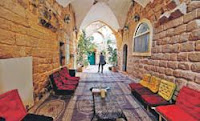A trip to Africa is a holiday of a lifetime for most travellers, but for marketing executive Rina Yazid, 29, and her husband, it was to learn about the Great Apes. The trip saw them volunteering their time at sanctuaries for gorillas and chimpanzees in Rwanda and Uganda. Today talks to Rina about her travels to east Africa and why she decided to spend her holiday last year caring for primates.
When did you become interested in volunteer tourism?
My husband and I have been working with charity organisations like The Christina Noble Children’s Foundation for a few years now. While these are extremely worthwhile causes, it is more interesting and engaging to spend time with the mountain gorillas and chimpanzees at The Jane Goodall Institute at Ngamba Island, Uganda, and The Dian Fossey Gorilla Foundation in Rwanda. We have been fascinated by primates — and Africa — all our lives.

It also helps that (primatologists) Jane Goodall and Dian Fossey have been idols of ours since childhood. We have always wanted to get lost in the jungles of Africa and do something like these women.
What did your work at the sanctuary involve?
First — feeding the chimps. These guys eat all day long in the wild but in the sanctuary they have to be fed because the island (Ngamba) cannot sustain them. That means the caregivers have to prepare specific meals for them and they have to be fed four times a day. The morning feeding is the most fun because they are all so active and boisterous.
The sort of food they eat is carrots, mangoes, jack fruit, sweet potato and watermelon. These are cut and mixed in buckets and once the head keeper says we can start, we gradually throw the food out to the chimps, making sure we spread it out as fairly as possible. The big ones will have first go at the food, so we keep some of it back for the smaller ones and females.
After the feeding, we can either help clean the cages that the chimps spend the night in or help with the recording of daily activity notes. These are notes for caregivers to keep track of what is happening over time with the chimps.
The best “job” is taking a walk with the chimps into the jungle. You cannot help but feel at one with them. They come out of the cage and walk straight to the person they want to be with. It’s an amazing feeling to have a chimp pick you as their friend.
Once they have your hand, they climb on your back and you piggy back them through the jungle for an hour or so. Along the way, you will stop for a rest where the chimps will present their backs or arms or legs for you to clean for them; and while you may not be cleaning anything off them, it is a form of bonding and for them to get to know you better. After a while they may reciprocate and start cleaning the fictitious bugs from your clothes and the feeling is absolutely priceless.

What are your impressions of Uganda and Rwanda?
Everyone thinks of Singapore as a clean country — Rwanda is clean, too! This is hands down the cleanest country we have ever been to. Truck drivers have their plastic bags confiscated as they cross the border. There is no rubbish anywhere — even in the drains of the capital city Kigali.
Rwanda now has a reputation in Africa as the least corrupt nation on the continent and it shows. The police are stern-faced but polite. The border guards are all stiff and unfriendly but not intimidating in any way.
There are reminders all over the country of the horror of the genocide but that was over 10 years ago and if you ask a Rwandan if they are Hutu or Tutsi, they will answer “I am Rwandan/Rwandese”. The war is over and they have moved on. It is a nation of forgiveness and this shows everywhere.
As for Uganda, I will admit that we did ask all the compulsory questions about safety and getting around. We were told there is nothing to worry about and kind of left it at that. At no point during the trip did I feel I was in any danger. The only guns we saw were with the park rangers and they were with us and held the guns for protection against what lurks in the jungles (wild animal attacks).
How did you book your trip?
We worked through a travel agency in South Africa called African Pride who concentrate on Southern Africa but partner with Wild Frontiers for central and east Africa.
The trip was 18 days and covers Rwanda and Uganda. The Africa package, including flights to Entebbe and all hotels, transfers, driver, food, tours, treks, park fees and just about everything else was about US$17,000 ($26,000) for two people.
We could have done it more cheaply had we not stayed in expensive lodges. What we got from this trip, though, were memories to last a lifetime and a passion and respect towards all primates that have got stronger ever since.
From TODAY, Traveller – Thursday, 21-May-2009
![Reblog this post [with Zemanta]](http://img.zemanta.com/reblog_e.png?x-id=7bfec1fd-919c-45bc-87e8-833aa8eb497a)


![Reblog this post [with Zemanta]](http://img.zemanta.com/reblog_e.png?x-id=d90622a4-ce11-403d-9526-639746d3d5b5)





![Reblog this post [with Zemanta]](http://img.zemanta.com/reblog_e.png?x-id=05cb678d-c71f-46f4-91f1-85ccec45efb1)
![Reblog this post [with Zemanta]](http://img.zemanta.com/reblog_e.png?x-id=4995e316-7f91-41a3-adad-a51b191284c2)

![Reblog this post [with Zemanta]](http://img.zemanta.com/reblog_e.png?x-id=3052318b-8e38-4023-a4a3-639cd3b1210b)



![Reblog this post [with Zemanta]](http://img.zemanta.com/reblog_e.png?x-id=3329bd77-8009-4c65-9ab0-41a57ab41ff7)





![Reblog this post [with Zemanta]](http://img.zemanta.com/reblog_e.png?x-id=d51e3055-be69-4a76-8efb-659bb85310a1)